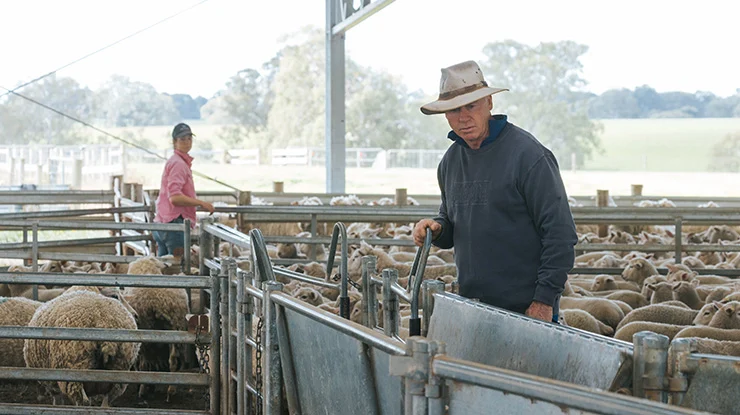
FOR south-west Victorian prime lamb producers Tim and Georgie Leeming, removing adverse animal husbandry practices and administering pain relief are huge priorities, deeply embedded in their personal beliefs and their business case.
Lamb survival and lamb performance are the key profit drivers that inform all the Leemings’ management decisions within their self-replacing prime lamb enterprise, Paradoo Prime.
They’re quick to utilise every tool available to improve survival rates and deliver healthier and more robust lambs and higher overall productivity and profitability.
Wellbeing a priority
Ever since they started building their own flock in 1997, the Leemings have prioritised the health and wellbeing of their livestock.
“Taking away adverse pain from animals is super important for us, it’s our philosophy that we as an industry have to be ahead of the game. It’s such a great thing that industry has taken on-board human grade pain relief for animals,” Mr Leeming said.
“If you look after your livestock, make sure they’re not in pain and feed them the optimum amount of nutrition, then it’s a win-win situation for our animals and the business.”
Their pain management journey began by targeting mulesing with genetics.
By breeding plainer-bodied, breech wrinkle-free sheep, their flock developed flystrike resistance – eliminating the need for mulesing and making crutching a much simpler process. Their genetic selection has also delivered a stronger worm tolerance, requiring just one annual drenching.
Tim and Georgie Leeming also contributed sheep to a MLA-supported trial of Numnuts, an injectable product used with a ring for tail docking and castration, which provides an effective pain relief solution during necessary husbandry practices.
They have found that mobs are able to return to their paddocks after procedures three times faster when on pain relief, aiding in the logistical ease of the process.
Increasing survival rates
Another cornerstone in the Leemings’ commitment to animal welfare is intensive management to minimise stress, particularly for ewes during lambing.
Paradoo’s rigorous ‘precision lambing system’ entails multiple steps to ensure high lamb survival.
These include shorter strategic joinings, smaller paddock sizes, smaller mob sizes for all bearing ewes, tailoring nutrition to the needs of pregnant ewes, intensifying supervision of pregnant ewes and dedicated lambing paddocks with shelter.
They have reduced mob size to less than 50 for twin-bearing ewes and just 14 in triplet-bearing mobs – in 4-5ha paddocks and a stocking rate of 7–10 ewes/ha (for twins).
The results are consistent paddock survival rates of around 90pc, despite having well-above-average stocking rates and conception.
In 2020, 1.85 foetuses per ewe were conceived, including rising two-year old ewes, and 1.66 lambs per ewe were weaned. In 2021, conception increased to 1.92 lambs/ewe, with a weaning of 1.66 lambs/ewe.
“We all understand that stocking rate and increases in reproductive rate is a big driver of profitability,” Mr Leeming said.
“To wean more lambs, we need to conceive more. However, we strongly believe we have a moral responsibility to only increase conception if we can successfully optimise lamb survival at our current levels.
“There’s a number of simple things around management practices that producers can do that cost very little but can have some massive impacts on your profitability as a business.”
Sustainable approach to grazing
When it comes to grazing management, monitoring and timing are key tactics to increase the sustainability of Paradoo’s land and flock.
They match feed to animal demand to optimise nutritional benefits and practice vigilant management for flystrike, such as timing management operations to avoid fly waves and understanding the environment and weather patterns.
For example, the Leemings move weaned ewes that are susceptible to body strike from moist areas, such as gullies, to higher-altitude areas with dry wind for them to dry off and avoid the fly waves.
Other strategies they employ to build the resilience and efficiency of their business include:
- reticulated water systems
- reduced paddock size, grazing in larger mobs at different times of the year to manage weeds
- consistent movement of mobs to utilise the land effectively
- grain-based supplementary feeding to fill the summer/autumn feed gap (however, ewes are consistently grassfed during the winter lambing season).
Source: MLA

Part of the problem lies with access to pain relief products. For example, the previous model for Tri-Solfen to resellers was as an on consignment product where the risk of ageing inventory stayed with the owner who was Bayer Animal Health. The new distribution model for that product now means that resellers own the product and all the risk and with a very short shelf-life, for some, the risk of writing down expired stock is too great. For others it means the prospect of selling out of date products to willing buyers. This can lead to the product not working as claimed on the label and therefore potentially having an adverse effect on animal welfare. I suspect that where there was once in excess of 80% use in certain sheep procedures such as marking and in particular mulesing but the percentage of farmers actually able to get access to topical anesthetics may have decreased and along with it overall use. The wool declaration askes for AA to be ticked but it doesn’t necessarily differentiate between anesthesia and analgesics which are two very different things when it comes to pain treatment. Meloxicam is a wonderful pain treatment option in it’s various forms but it falls short of what could be considered a gold standard when used in conjunction with a topical anesthetic.